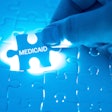
As a dental hygienist, I have experienced many situations with maintaining and repairing dental implants when patients present themselves for their regular (or irregular) dental recare/recall visits. Patients often wait until their scheduled maintenance visit to inform the office that their implant(s) need attention. They report such issues as inflammation, loose crowns, and excess cement around new implants to be remedied at the appointment.
Documenting the observations and the patient complaints on the patient record is essential for the dentist to see when they perform the evaluation and diagnoses and then present treatment recommendations.
Even though the patient may want implant services and regular maintenance visits combined, often, the insurance payer doesn't see it that way. Each plan in the network will have a differing policy regarding payment for implant maintenance services.
Coding for these situations may confuse the dentist and the insurance coordinator, who must become more familiar with coding for unusual implant scenarios. Dental staff often contact me for answers to their coding dilemmas when they receive denials from insurance plans.
Implant coding Q&As
Below is a case history to demonstrate my point in coding procedures correctly.
Q: Patient A came in for their four-month periodontal maintenance (D4910) appointment with the hygienist. The patient reported that his implant was sensitive and bled when he brushed it. A radiograph revealed some cement was left at the site when the implant was seated a year ago. The implant looked fine, and there wasn't any evidence of bone loss at the site. The area was scaled and debrided. The claim was submitted for D4346 and was denied. What should I have done?
A: The code D6081 should have been reported for scaling and debridement of implants. The code descriptor is for scaling and debridement in the presence of inflammation, mucositis, or a single implant, including cleaning the implant surfaces without flap entry and closure. If there is more than one implant, each one should be listed on the chart and the claim form should indicate the tooth number of each implant.
This procedure (D6081) is not performed with D1110, D4910, or D4346. If performed at the same appointment as the D6081, these services may not be covered by some plans. In the case of an implant-supported fixed prosthesis that is removed from the patient, cleaned, and then reinserted, use the code D6080 (implant maintenance procedures when the prosthesis is removed and reinserted, including cleansing the prosthesis and abutments.) This is not a per-implant code and is indicated for implant-supported fixed prostheses. The procedure includes debridement of the implant and full examination of the complete implant system, including occlusion and stability of the superstructure.
In the case of a dental implant that needs to be repaired, use D6090 -- repair implant-supported prosthesis. Clinical notes must be included to describe the repair that occurred.
In the case of an implant that has come out but there are no problems with the fixture or abutment, the implant can be recemented using the code D6092 (recement or rebond implant/abutment supported crown).
In the case of replacing restorative material (not a repair), use D6197 (replacement of restorative material used to close an access opening of a screw-retained implant-supported prosthesis, per implant).
Q: How do I code for this situation? My patient has food impacted in an open contact between the dental implant crown and a natural tooth. I removed the implant crown and returned it to the lab to add porcelain (placing a healing abutment).
A: Use code D6090 to repair an implant-supported prosthesis. The procedure involves repairing or replacing any part of the implant-supported prosthesis. It is imperative to include clinical notes (in a brief narrative) with the original date of placement and a description of the repair.
In a situation where the implant abutment needs repair or replacement, code D6095 is used. It describes repairing or replacing any prefabricated part (D6056) or custom abutment (D6057).
These are just a few implant codes contained in the Current Dental Terminology (CDT) manual that are specific to implant issues. If you have a situation that doesn't fit any listed code procedure, then use D6199 (unspecified implant procedure, by report) -- which is used for a procedure not adequately described by a code -- and describe the procedure from the clinical notes in a narrative.
A proper guideline for coding implant maintenance is to always "code what you do" by choosing the codes that best represent the treatment and materials provided. If dental implants are not cleaned, inspected, and repaired, when necessary, there is a chance of dental implant failure or its components.
* Dental implants yield excellent long-term results with 10-year success and survival rates above 95%. The reasons for implant failure are still being studied. A thorough medical history is imperative to weigh the risk factors of implant failure. Smoking and radiotherapy have been shown to increase implant failure. Studies have shown diabetes and osteoporosis are also risk factors, though more thorough studies are needed to confirm an association.¹
Reference
1. Hatfield, S. Implant maintenance: An overview. Today’s RDH Website. https://www.todaysrdh.com/implant-maintenance-an-overview/. February 8, 2021.
Estela Vargas, CRDH, is the founder and CEO of Remote Sourcing, a dental insurance billing and revenue recovery service. She is a graduate of Miami Dade College's dental hygiene program. Vargas' extensive background in the clinical arena of dentistry is coupled with her experience as a practice administrator and business executive.
The comments and observations expressed herein do not necessarily reflect the opinions of DrBicuspid.com, nor should they be construed as an endorsement or admonishment of any particular idea, vendor, or organization.



















